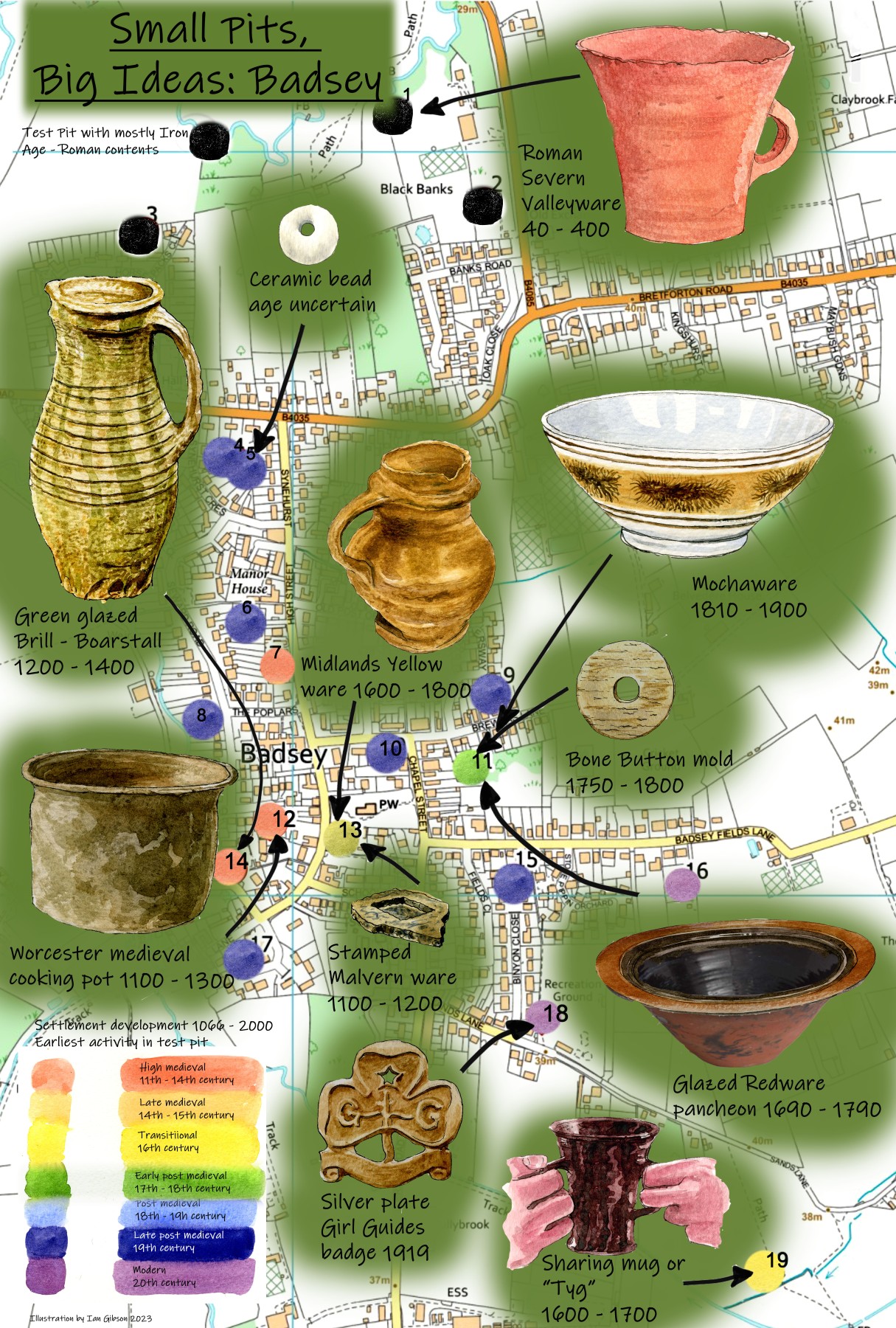Over the winter of 2022/23 the results of the six county wide Digs were analysed and written up. Badsey received its results talk on the evening of March 17th from Nina O’Hare, the community archaeologist from Worcester Archaeology and Archive Service, who was the organiser for the whole project.
As at early July 2023 news has come through that the Worcestershire Test Pits project has been shortlisted for the prestigious Marsh Community Archaeology Awards, which will take place near the end of July. This would be the second time this has happened for the Badsey Society. In 2008 we were successful in being joint winners for our Enclosure Map project and Maureen Spinks and Richard Phillips went to Olympia to receive it. This year due to train strikes the presentation will take place online.
To see a video of this talk (and the other dig talks) follow the link below:
Small Pits, Big Ideas – unearthing stories of medieval Worcestershire
The Small Pits idea was first tried in East Anglia and one of the main findings was how big changes in population had occurred in villages during the Black Death outbreak which reached England in 1348. One question about Worcestershire is did it suffer as much as East Anglia from the Black Death? In Badsey there may have been village shrinkage but there was continuous occupation through and after the pandemic.
Badsey is first mentioned in the 8th Century and there has been plenty of Roman pottery found around the village. Also Saxon coins have been found.
There was a good spread of 19 pits across the village with a total of 86 volunteers involved.

A brief summary of the dig results follows:
- Finds came from all periods from Roman to modern times with the exception of the Saxon period which due to the perishable nature of Saxon vessels rarely leaves any traces. One flint find suggests prehistoric activity here as well.
- The northern test pit at Black Banks contained 18 sherds from the mid to late Iron Age and 87 sherds of worn local Severn Valley ware from the Roman period up to 400 AD. A hobnail was found probably from a Roman shoe or sandal.
- Further south 2 pits at Banks Road and Horsebridge Avenue revealed small amounts of Roman and Victorian pottery suggesting that these areas were at the edge of the settlement until recently.
- 2 pits in Synehurst Crescent had no mediaeval finds and then small amounts of broken pottery from the 18th and 19th centuries. This may have been from the common practice of scattering old broken pots over agricultural land to improve drainage.
- Near the centre of the present day village 3 pits in the gardens of modern houses on the High Street and Seward Road produced rubble from modern disturbance but a Roman potsherd near the brook and a piece of a mediaeval cooking pot. Test pit 7 held several types of very colourful 18th Century pottery.
- Along Brewers Lane 3 test pits produced from gardens of Victorian houses a large amount of pottery from the late 15th to the 18th Century.
- A group of 3 pits in modern gardens at the southern end of Seward Road and at the top of Mill Lane yielded the usual 18th Century pottery waste but also some unusual mediaeval pottery with one piece of Newbury B ware which is very rare in this area.
- Test Pit 13 in the garden of a Victorian house next to the church produced a large number of finds and was the only location showing a complete sequence from the early mediaeval period to the 19th Century. There was even a Roman sherd and a small flint flake indicating a human presence since prehistoric times.
- 2 test pits along Badsey Fields Lane revealed a small amount of Roman pottery but nothing until the 17th Century which bucks the trend of the other pits.
- The pit in the recreation ground dug by Scouts produced a small number of Roman, medieval and post medieval pottery and also ironically a 1919 Girl Guides promise badge alongside a George V penny.
- The most southerly pit in market garden land off Sands Lane only produced 22 finds but this was enough to show a continuous presence from Roman times to the 20th Century.
- In conclusion the dig has shown that Badsey has been inhabited for a very long time. There was a strong Roman presence particularly to the north of the present day village, and continuous occupation through Saxon times to the present. The central part of modern Badsey was established in mediaeval times. A Victorian population boost began the process of enlarging the village and Badsey has continued to grow to the present day.
- In comparison with the other villages taking part in the project, Badsey is notable for having more Roman evidence and since the Saxon period has had an established centre, whereas other villages have started out as separate small settlements which have joined together over the centuries.
Ian Gibson, July 2023
